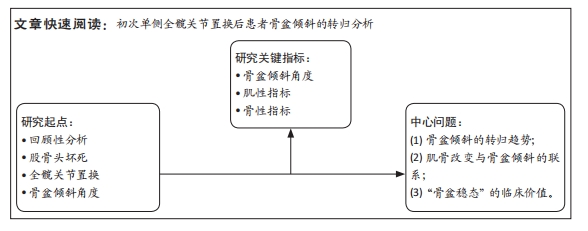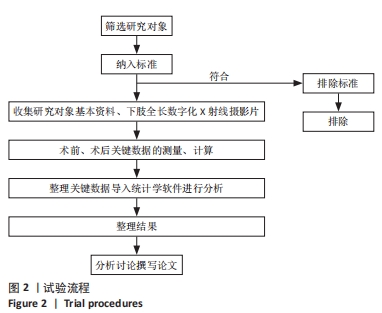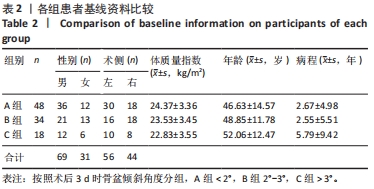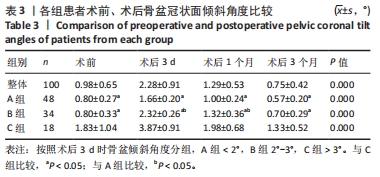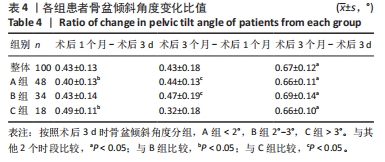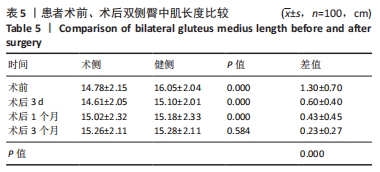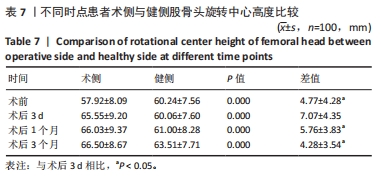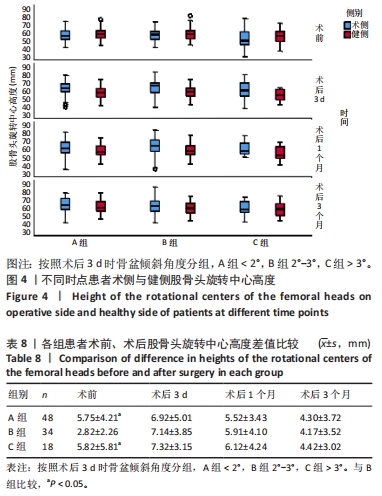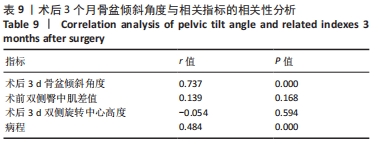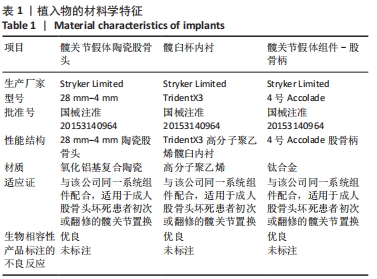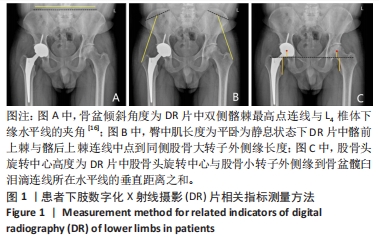[1] VARACALLO M, LUO TD, JOHANSON NA. Total Hip Arthroplasty Techniques. In: StatPearls. Treasure Island (FL): StatPearls Publishing; 2022.
[2] KRUMME JW, BONANNI S, PATEL NK, et al. Technical Considerations and Avoiding Complications in Total Hip Arthroplasty. J Am Acad Orthop Surg Glob Res Rev. 2022;6(11):e22.00234.
[3] RIVERA F, COMBA LC, BARDELLI A. Direct anterior approach hip arthroplasty: How to reduce complications - A 10-years single center experience and literature review. World J Orthop. 2022;13(4):388-399.
[4] BARNETT SL, PETERS DJ, HAMILTON WG, et al. Is the anterior approach safe? Early complication rate associated with 5090 consecutive primary total hip arthroplasty procedures performed using the anterior approach. J Arthroplasty. 2016;31(10):2291-2294.
[5] TATEIWA T, ENDO K, MATSUOKA Y, et al. Pelvic tilt after total hip arthroplasty in patients with osteoarthritis of the hip. J Orthop Surg (Hong Kong). 2020;28(2):2309499020918317.
[6] SLAVKOVIĆ N, VUKAŠINOVIĆ Z, BAŠČAREVIĆ Z, et al. Total hip arthroplasty. Srp Arh Celok Lek. 2012;140(5-6):379-384.
[7] JI QH, QIAO XF, WANG SF, et al. Effectiveness of neuromuscular electrical stimulation and ibuprofen for pain caused by necrosis of the femoral head: A retrospective study. Medicine (Baltimore). 2019; 98(11):e14812.
[8] 李权. 基于骨肌模型脊椎-骨盆系统对髋关节生物力学影响研究[D].成都:西南交通大学,2021.
[9] 叶永恒,何沛恒,唐金平,等.全髋关节置换术中用部分臀大肌重建臀中肌的临床观察[J].中华显微外科杂志,2020,43(6):558-561.
[10] 郝晓艳.儿童臀肌挛缩致骨盆倾斜的术后功能锻炼[J].实用临床医药杂志,2011,15(23):148-149.
[11] 尚应烈. 全髋关节置换术中关节旋转中心测量对下肢长度影响的评估[D].济南:山东大学,2014.
[12] KAZARIAN GS, SCHLOEMANN DT, BARRACK TN, et al. Pelvic rotation after total hip arthroplasty is dynamic and variable. Bone Joint J. 2020;102-B(7_Supple_B):47-51.
[13] NISHIWAKI T, HATA R, OYA A, et al. Pelvic Tilt Displacement Before and After Artificial Hip Joint Replacement Surgery. J Arthroplasty. 2018;33(3):925-930.
[14] 胡勇,周庞虎,邱波.全髋关节置换术后双下肢不等长的评估[J].中华关节外科杂志(电子版),2020,14(2):201-205.
[15] HALEEM AM, WILEY KF, KUCHINAD R, et al. Total Hip Arthroplasty in Patients With Multifactorial Perceived Limb Length Discrepancy. J Arthroplasty. 2017;32(10):3044-3051.
[16] JOHNSTON RC, BRAND RA, CROWNENSHIELD RD. Reconstruction of the hip. A mathematical approach todetermine optimum geometric relationships. J Bone Joint Surg Am. 1979;61(5):639-652.
[17] KONARSKI W, POBOŻY T, ŚLIWCZYŃSKI A, et al. Avascular Necrosis of Femoral Head-Overview and Current State of the Art. Int J Environ Res Public Health. 2022;19(12):7348.
[18] 张锡华. 髋关节疾病引起骨盆倾斜的原因分析[D].昆明:昆明医科大学,2015.
[19] BENEDETT MG, CATANI F, BENEDETTI E, et al. To what extent does leg length discrepancy impair motor activity in patients alter total hip arthroplastyll.Int Crhea. 2010;34:1115-1121.
[20] DESAI AS, DRAMIS A, BOARD TN. Leg length discrepancy after total hip arthroplasty: a review of literature. Curr Rev Musculoskelet Med. 2013;6(4):336-341.
[21] CLAES L, REUSCH M, GÖCKELMANN M, et al. Metaphyseal fracture healing follows similar biomechanical rules as diaphyseal healing. J Orthop Res. 2011;29(3):425-432.
[22] SCHLEDER JSEL, RAMELLO DCS, CARON MD, et al. Biomechanical Gait Analysis in Patients with Osteonecrosis of the Femoral Head. Rev Bras Ortop (Sao Paulo). 2023;58(3):500-506.
[23] YUAN BT, QU F, WANG SX, et al. Histology and molecular pathology of iliotibial tract contracture in patients with gluteal muscle contracture. Biosci Rep. 2019;39(9):BSR20181351.
[24] 张佳,李春宝,刘玉杰.臀肌激活与运动性损伤[J].中国矫形外科杂志,2022,30(5):436-440.
[25] GANDBHIR VN, LAM JC, RAYI A. Trendelenburg Gait. In: StatPearls. Treasure Island (FL): StatPearls Publishing; October 6, 2022.
[26] KOPEĆ K, BEREZA P, SOBOTA G, et al. The electromyographic activity characteristics of the gluteus medius muscle before and after total hip arthroplasty. Acta Bioeng Biomech. 2021;23(1):187-195.
[27] 陈永程,姚彬,刘磊,等.基于“骨正筋柔”理论探讨截骨矫形术在膝骨性关节炎中的应用[J].现代中医药,2023,43(4):50-54.
[28] 范小铁.全髋人工关节置换术应用于髋关节疾病合并骨盆严重倾斜畸形的疗效分析[J] . 医护论坛杂志,2012,19(33):179-180.
[29] 孟乘飞,蔡贤华,刘曦明,等.全髋关节置换术对单侧股骨头坏死骨盆倾斜的影响[J].中国矫形外科杂志,2018,26(19):1765-1769.
[30] MANCINO F, CACCIOLA G, DI MATTEO V, et al. Surgical implications of the hip-spine relationship in total hip arthroplasty. Orthop Rev (Pavia). 2020;12(Suppl 1):8656.
[31] SULTAN AA, KHLOPAS A, PIUZZI NS, et al. The Impact of Spino-Pelvic Alignment on Total Hip Arthroplasty Outcomes: A Critical Analysis of Current Evidence. J Arthroplasty. 2018;33(5):1606-1616.
[32] ROUSSOULY P, PINHEIRO-FRANCO JL. Biomechanical analysis of the spino-pelvic organization and adaptation in pathology. Eur Spine J. 2011;20 Suppl 5(Suppl 5):609-618.
[33] YU Y, SONG K, WU B, et al. Coronal Compensation Mechanism of Pelvic Obliquity in Patients With Developmental Dysplasia of the Hip. Global Spine J. 2023;13(4):949-953.
[34] FERRERO E, LIABAUD B, CHALLIER V, et al. Role of pelvic translation and lower-extremity compensation to maintain gravity line position in spinal deformity. J Neurosurg Spine. 2016;24(3):436-446.
[35] LAZENNEC JY, BRUSSON A, ROUSSEAU MA. Lumbar-pelvic-femoral balance on sitting and standing lateral radiographs. Orthop Traumatol Surg Res. 2013;99(1 Suppl):S87-S103.
[36] PFEIFER R, DARWICHE S, KOHUT L, et al. Cumulative effects of bone and soft tissue injury on systemic inflammation: a pilot study. Clin Orthop Relat Res. 2013;471(9):2815-2821. |
